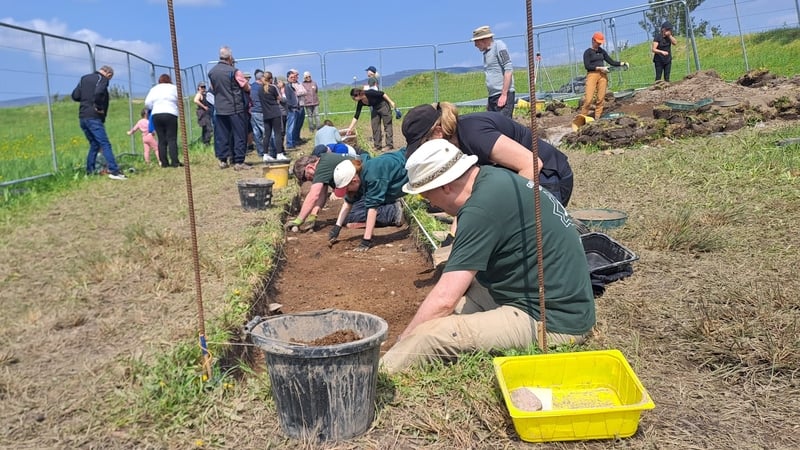

In a landmark excavation revealing the hidden depths of County Sligo’s storied past, over 1,000 artefacts dating back to the 17th century have been recovered from Green Fort, an impressive and intact earthen bastion fort situated in the heart of Sligo town. The three-week dig, led by archaeologists from the Atlantic Technological University (ATU), marks a pivotal step in uncovering the forgotten layers of Irish military and social history.
Green Fort: A Hilltop Sentinel Over Sligo
Perched atop Fort Hill in Rathquarter townland, the Green Fort commands 360-degree views of Sligo’s urban centre and surrounding landscapes. It is the last visible remnant of Sligo’s 17th-century fortifications and is protected as a National Monument under the National Monuments Acts. The fort is in shared ownership between Sligo County Council and the Health Services Executive, bearing witness to centuries of Irish military strategy and societal change.
Built during the Nine Years War (1594–1603) and active through the Confederate Wars and the Williamite Wars, Green Fort played a strategic role in controlling passage between Ulster and northwest Connacht. Its unique spear-shaped bastion design reflects its primary role: the mounting of artillery and protection of garrisons during conflict. By 1739, the fort lay in ruins, although it was still reported to house iron and brass weaponry.
A Monument Rediscovered
Although abandoned for nearly 300 years, Green Fort has recently become the focus of community-led preservation efforts. In 2017, Sligo County Council, in partnership with local heritage groups such as the Forthill Men’s Group Art & History Society, commissioned the Green Fort Conservation Plan. This initiative, supported by the Green Fort Technical Group and the National Monuments Service, aims to preserve the site and develop it as a cultural heritage destination.
On 30 August 2021, landscape contractors began vegetation management under Ministerial Consent, guided by archaeologist Eoin Halpin and ecologists from Woodrow Sustainable Solutions. The works are being supported through the Community Monuments Fund 2021, paving the way for geophysical surveys and a new heritage interpretation plan.
The Dig: Unlocking Centuries of Hidden History
Led by Dr. Fiona Beglane and involving students from ATU’s Certificate in Archaeological Excavation and Field Studies, the recent dig uncovered a wealth of artefacts. Among the 1,000+ items were:
-
Clay pipes used for tobacco smoking
-
Glass fragments and pottery revealing drinking and dining habits
-
Animal bones, shedding light on the fort’s diet
-
Musket balls, military buttons, and parts of a mortar bomb, directly tying the site to 17th-century warfare
-
Evidence of historic drainage systems and interior reconstruction
Students and volunteers from Ireland, the US, Canada, Australia, Germany, Belgium, Kosovo, and Ukraine took part in the excavation, working under expert guidance to deepen understanding of the fort’s function, architecture, and occupants.
From Rath-da-Britog to Green Fort
Historical records, including the Annals of the Four Masters, suggest that the Green Fort may have been built on the site of an early medieval ringfort known as Ráith dá Briotócc—possibly meaning “Dabhritog’s Rath.” This layered history enriches the site’s cultural significance, suggesting a continuum of habitation and importance long before its 17th-century militarisation.
The British Museum’s commemorative medal from 1691 depicts the Green Fort, underscoring its strategic importance during the Williamite capture of Athlone, Galway, and Sligo. Likewise, a map by Captain John Baxter around 1600 shows a bastioned fort on the north bank of the Garavogue River, believed to be the Green Fort itself.
Preservation with Purpose: A Community and National Effort
Heritage Officer Siobhán Ryan of Sligo County Council emphasised the significance of the site:
“Sligo is really fortunate to have a monument of national importance like the Green Fort in situ and undisturbed for nearly 300 years… We are taking a slow and considered approach to all works… It’s exciting to have this opportunity to rediscover Sligo’s Green Fort and engage with such a unique aspect of our heritage.”
As outlined in the Green Fort Conservation Plan, the long-term vision is to protect the fort while enhancing public access, educational use, and its potential as a tourist attraction within a public park setting.
Explore More of Sligo’s Enchanting Heritage
The Green Fort is just one piece in Sligo’s rich historical and natural landscape. Visitors can extend their journey through Ireland’s northwest with other stunning and storied destinations:
-
Rosses Point – a tranquil coastal retreat steeped in maritime lore
-
Glencar Waterfall – the poetic cascade that inspired W.B. Yeats
-
Knocknarea – home to Queen Maeve’s Grave, a majestic hill of myth
-
Strandhill – vibrant surf town full of charm and coastal adventure
-
Gleniff Horseshoe – an otherworldly loop rich in legends
-
Benbulben – Sligo’s iconic flat-topped mountain
-
Mullaghmore – a haven for surf, history, and scenic beauty
-
Queen Maeve’s Grave – unravelling the legend of Ireland’s warrior queen
-
Diarmuid and Gráinne’s Cave – a mythical lovers’ hideaway cloaked in story and stone
Conclusion: A Living Legacy Unearthed
As one of Ireland’s 65 bastioned forts, Green Fort stands as a living, breathing connection to centuries of Irish resilience, conflict, and community. With over 1,000 artefacts unearthed, and a dedicated conservation plan in action, the rediscovery of the Green Fort signals not just an academic achievement, but a cultural awakening—one that connects the people of Sligo to their ancient past while inviting the world to explore it.



